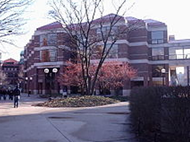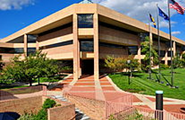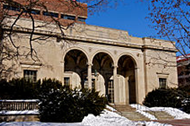
The Area Programs Libraries consists of four divisions: Near East; Slavic, East European, and Eurasian; South Asia; and Southeast Asia Division.[20]
• The Near East Division focuses on North Africa, Southwest Asia, Asia Minor, and Central Asia. As of 2013 the division had 597,507 monograph titles and 1,457 current serial titles. Represented are works in European languages (308,000 works), Arabic (174,427),Hebrew and Yiddish (55,477), Persian and Tajik (27,037), Turkish, Ottoman, or Turkic(32,136), and Kurdish (430).[21]
• The Slavic, East European, and Eurasian Division focuses on Eastern Europe, Mongolia, modern Greece, and Russia and the post-Soviet states, including Transcaucasia and Central Asia. Notable holdings of the collection include: "Russian revolutionary movements,Russian and East European dissident writings, modern Armenian history and literature, rare books and archives focusing on the Silver Age of Russian literature, Southeast European travel literature, and serial publications of the East European academies." The division has some 600,000 items, including some 427,800 monographs, 3,900 current serials in vernacular languages; 405,000 titles in Western languages, and 16,500 non-print media items, including microform and electronic resources. There are 86 languages represented, with the best-represented being Russian (163,650 items), Serbo-Croatian (45,000 items),Polish (60,000); Czech and Slovak (30,000); Armenian (22,500 items); and Central Asian languages (15,800 items).[22]
• University of Michigan Papyrology Collection
Shapiro Library

The Shapiro Library Building
The Hatcher Graduate Library is connected by a skyway to the Shapiro Library Building, which houses three libraries:
• Shapiro Undergraduate Library (referred to by the student population, affectionately, as the UGLi) is located in the basement, first and second floors of the Shapiro Library Building. It is a popular study and meeting place for UM undergraduates, and has a solid, generalist collection of about 200,000 books and journals.[citation needed] The UGLi also offers a great many services to its students, including Course Reserves, Reference Services, and the Research Consultation Program, which features one-on-one research assistance. The Peer Information Counseling Program also is located in Shapiro, and allows students to get research advice from fellow undergraduates. Café Shapiro is an annual forum for students, nominated by their professors, to read their creative work in a casual, coffeehouse-style environment. The UGLi is also home to Bert's Café, which opened in February 2008. The café was donated by Bertram Askwith (LSA '31), who is also the donor of the Askwith Media Library.
• Shapiro Science Library is housed on the third and fourth floor of Shapiro and is the primary university research center for astronomy, biology, chemistry, geology, natural resources, mathematics, physics, and statistics. The Shapiro Library contains over 400,000 print volumes and subscribes to over 2,000 journals.[23]
• Askwith Media Library, formerly the Film and Video Library, was recently renamed and moved to the second floor of the Shapiro Library Building. The Askwith Media Library contains over 25,000 titles, including feature films, documentaries, and instructional programs available for checkout or on-site viewing. Especially strong in foreign, animated, and documentary film, Askwith serves the entertainment and instructional needs of the university community.
Other Central Campus libraries
The University Library contains collections that support the university's museums:
• The Fine Arts Library, located on the second floor of Tappan Hall (the History of Art building) serves the History of Art department, the University of Michigan Museum of Art, the Kelsey Museum of Archeology. It holds over 100,000 volumes on "history, theory, andcriticism of the visual arts," including works on painting, drawing, sculpture, graphic arts, decorative arts, architectural history and photography.[24]
• The Museums Library is located in the Ruthven Museums building. It holds more than 130,000 cataloged volumes, with a focus on taxonomy, botany, zoology, behavioral biology,paleontology, and anthropology.[25]
• The Herbarium Library collection is housed in the University of Michigan Herbarium on Varsity Drive.[26]
Taubman Health Sciences Library
One of the largest medical libraries in America with comprehensive collections in all facets of health care and medical research, the Taubman Health Sciences Library also has extensive online collections and is a member of the National Network of Libraries of Medicine, a gateway for access to over a thousand medical libraries nationwide. The Taubman Health Sciences Library has recently introduced the Clinical Librarian Service for the growing information needs of health professionals within the University of Michigan Health System who cannot easily leave their units, clinics or health centers.
The Alfred Taubman Health Sciences Library Rare Book Room, located in Room 5919, contains rare volumes of significance to the history of medicine.[27] Access is by appointment only.[27] The Rare Book Room contains approximately 6,300 titles dating from 1470 to the early 20th century, consisting primarily of pre-1850 imprints.[27] It includes 82 incunabula, 52 magical medical amulets, as well as medical fugitive sheets, manuscripts, letters, medical cartoons, medical portraits, medical illustrations, and medical artifacts.[27] Particular strengths of the collection are early 19th-century American medical literature; anatomy; surgery; homeopathy; pharmacy and materiamedica; obstetricsand gynecology; cardiology; pathology; and hernia treatment.[27]
North Campus libraries

Duderstadt Center "The Dude", which houses collections in art, architecture, and engineering
Two University Libraries are located on the UM North Campus: the Music Library and the Art, Architecture & Engineering Library. The Music Library is located on the third floor of the Earl V. Moore Music Building. The Music Library's collections feature extensive materials in performance, musicology, composition, theory, and dance. It also includes scores, serials, and sound and video recordings in many formats. The Art, Architecture & Engineering Library, located in the Duderstadt Center, features over 600,000 volumes, thousands of periodicals, and over 200 databases in the disciplines of art and design, architecture, engineering, and urban planning.[citation needed] The library has especially strong collections in early twentieth-century art and design, with many materials on the Bauhaus school, Le Corbusier, Louis Sullivan and Frank Lloyd Wright.
Independent libraries

William L Clements Library
There are also several collections that are affiliated with the university, but are not part of the University Library system. Two historical libraries are the Bentley Historical Library and theWilliam L. Clements Library. The former is home of the University of Michigan's archives as well as the Michigan Historical Collections, while the latter houses original resources for the study of American history and culture from the 15th to the early 20th century. The Clements Library is believed to be the first stand alone rare books collection at a public university.[citation needed]
Other libraries include the Law School Library, the Ronald and Deborah Freedman Library of the Population Studies Center, and the Transportation Research Institute Library. The last library is one of the world's most extensive collections of literature on traffic safety. There is also a large number of independent departmental libraries, as well as small libraries in many student dormitories.
Off-campus facilities
The only off-campus library in the University of Michigan system is the Biological Station Library. Its collection consists of over 16,000 cataloged volumes and more than 50 paper journals.[28] It specializes in limnology, ornithology, ecology, systematics, taxonomy, andnatural history. Located in Pellston, Michigan, near the northern tip of the Lower Peninsula of Michigan, the University of Michigan Biological Station is dedicated to education and research in field biology and environmental science.
Not considered an independent library, but nevertheless a key facility for the entire U-M library system, the Buhr Remote Shelving Facility stores in a preservation-sensitive environment over two million items too fragile or rarely-used to be kept in the main libraries.
Challenges and opportunities
MPublishing
MPublishing "is the hub of scholarly publishing at the University of Michigan."[29]
Major activities of MPublishing include: "publishing monographs in print and electronic forms; Hosting and publishing journals, with an emphasis on online, open-access formats; developing new digital publishing models with the potential to become community portals for wider knowledge sharing; creating permanent, accessible versions of faculty publications and related materials; publishing and copyright consultation and education; rights advocacy for University of Michigan authors; reissuing materials from our collections and our faculty in new forms (reprints, electronic editions)."[29]
MPublishing hosts and helps operated 25 University of Michigan-based journals and scholarly conference proceedings in a variety of fields.[30] It also operates Deep Blue, the university's institutional repository.[31]
MPublishing operates several print-on-demand programs. The University of Michigan Faculty Reprints (FRS) returns out-of-print books written by university faculty back into circulation on an openly accessible and affordable basis, both online and in print. The library also has an Espresso Book Machine on the first floor of the Shapiro Undergraduate Library.[32]
The University of Michigan Press is a component of MPublishing.[33]
Digitization
Since the early 1990s, the University of Michigan Library has been a leader among research libraries in efforts to digitize its vast collections. The Digital Library Production Service (DLPS) of the U-M Library oversees the digitization of Library materials, and the development of online access systems for these digitized materials. In furtherance of this goal, DLPS developed its own digital library software, called Digital Library Extension Service (DLXS), that provides a uniform interface for its digitized items. DLPS oversees the scanning and optical character recognition of about 5,000 texts per year, many of them rare, brittle, or delicate.
The Digital Library Production Service hosts many searchable digital collections.[34] Among them are:
• The Corpus of Middle English Prose and Verse, a collection of 54 Middle English texts variously digitized for the project by the university's Humanities Text Initiative and collected from University of Michigan faculty and texts provided by the Oxford Text Archive,[35]
• The University of Michigan Historical Mathematics Collection, a collection of works of mathematics published in the 19th and early 20th centuries.[36]
• Advanced Papyrological Information System (APIS UM)
• American Verse Project
• Making of America
• Michigan County Histories and Atlases
• Middle English Compendium
DLPS is also affiliated with the Text Creation Partnership (TCP) to create searchable, full-text versions of works digitized in the Early English Books Online, Evans Early American Imprints, and the Eighteenth Century Collection Online projects. TCP, when its work is concluded, will have produced over 40,000 XML-encoded text files—making it one of the largest collections of its kind.
Google and HathiTrust
In December 2004 the University Library and Google announced their plans to digitize the over 7 million print volumes held by the Library. Especially old and fragile items, or items in special collections, will not be handled by Google; these the Library will scan itself. It is estimated that it will take approximately six years for Google to complete the scanning process; without Google, the U-M Library was on pace to have their entire collection scanned in about 1000 years. All costs for the project are borne by Google, and the company has developed special scanning technology to ensure that the books are not damaged during the process. All books that are out of copyright will be available for the public to read online; those still in copyright will be searchable, but only brief excerpts will be available to read. Copyright holders, such as publishers and authors, who do not want their books to be scanned can request to have their works excluded from the project, though the Library and Google both maintain that authors and publishers benefit from having their works digitized, since it will make them easier to find and will potentially bring more sales.
Though the project has been revolutionary, it is not without controversy. In September 2005a lawsuit was filed against Google charging copyright infringement. The lawsuit is still pending, but the scanning goes on.[4]
On June 6, 2007, twelve universities cooperating as the Committee on Institutional Cooperation[37] (CIC) announced a new partnership with Google whose explicit goal was to offer a public, shared digital repository of all the open access content.[38] That shared repository of library partners became HathiTrust.[39] The University of Michigan, which developed the MBooks platform for its own digitized books, partnered with Indiana University and the CIC libraries and the University of California system to create governance and models for financial support. The partnership has grown to include more than 60 institutions.[40]
ARL rankings
Using a variety of metrics such as accessibility, materials expenditures, volumes held, and staff size, the Association for Research Libraries (ARL) has consistently ranked the UM library system among the top ten in the nation.[41] Although Michigan ranks 8th among academic libraries as to total volumes held, it ranks 1st for unique titles held among all institutions reporting that statistic.
Year Volumes Held Volumes Added Gross Current Series Total Expenditures Total Staff Investment Index Score Investment Index Rank
2009 9,575,256 176,363 70,047 $53,134,323 584 1.65 5
2008 9,175,102 146,729 69,457 $51,599,110 570 ** 8
2007 8,414,070 157,552 71,788 $50,591,407 585 ** 8
2006 8,273,050 176,998 134,446 $49,053,402 574 * 8
2005 8,133,917 189,373 124,809 $47,113,239 473 1.24 5
2004 7,958,145 171,154 67,554 $46,737,671 475 0.98 8
2003 7,800,389 173,081 74,664 $48,193,379 497 1.13 5
2002 7,643,203 182,670 69,218 $43,357,616 514 1.05 6
2001 7,484,343 172,287 68,684 $43,558,787 501 1.05 6
2000 7,348,360 179,392 68,798 $41,368,972 459 1.06 6
References
1. ^ http://www.lib.umich.edu/statistical-highlights
2. ^ Libraries, University of Michigan Library.
3. ^ a b Libraries & Archives, University of Michigan Library.
4. ^ a b DigitalKoans » Blog Archive » The Google Print Controversy: A Bibliography
5. ^ "EBM Locations: List View". OnDemandBooks.com. Retrieved 2012-05-14.
6. ^ a b c d e f g h i j k l m n o p q r s t A Brief History of the University of Michigan Library
7. ^ Collections at the Graduate Library
8. ^ Department Directory of the Hatcher Graduate Library.
9. ^ a b c d About Asia Library, University of Michigan Library.
10. ^ Clark Library.
11. ^ a b Clark Library Map Collections, University of Michigan Library.
12. ^ Map Collection Highlights.
13. ^ Clark Library Government Information Collection.
14. ^ Highlights.
15. ^ Spatial and Numeric Data Services (SAND).
16. ^ a b c About the Special Collections Library
17. ^ a b c d e f g h i j k l m Special Collections Library - Collections
18. ^ The Galileo Manuscript
19. ^ The Worcester Philippine History Collection.
20. ^ Area Programs Libraries
21. ^ Near East Division.
22. ^ Slavic, East European, and Eurasian Divisions.
23. ^ About Us.
24. ^ Fine Arts Library.
25. ^ Museums Library
26. ^ Museums Library
27. ^ a b c d e Taubman Health Sciences Library Rare Book Room.
28. ^ Biological Station Library (Pellston): About Us
29. ^ a b About Us, MPublishing.
30. ^ Journal Services, MPublishing.
31. ^ Deep Blue at MPublishing; Deep Blue.
32. ^ Print on Demand Services, MPublishing.
33. ^ University of Michigan Press.
34. ^ University of Michigan digital collections
35. ^ Corpus of Middle English Prose and Verse; About the Corpus of Middle English Prose and Verse
36. ^ University of Michigan Historical Mathematics Collection
37. ^ http://www.cic.net/Home.aspx
38. ^ CIC: Partnership Announced Between CIC Libraries And Google
39. ^ HathiTrust
40. ^ HathiTrust: About
41. ^ Martha Kyrillidou and Mark Young (2006). "ARL Statistics 2004-05 A Compilation of Statistics from the One Hundred and Twenty-three Members of the Association of Research Libraries". Association of Research Libraries.



















